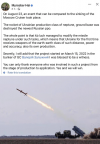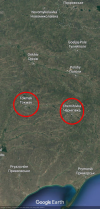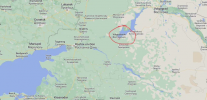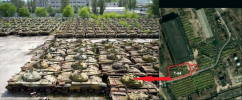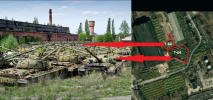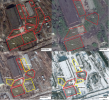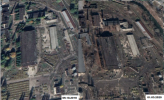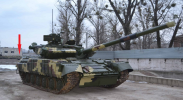https://bmpd.livejournal.com/4496317.html
The state and development of the armored industry of Ukraine after 2014
The first issue of Arms Export magazine for 2022 published an article by Ruslan Pukhov, director of the Center for Analysis of Strategies and Technologies (CAST) , dedicated to the development of the armored industry in Ukraine after 2014. The bmpd blog provides the text of the article.

By February 2014, the armored cluster of the Ukrainian state concern "Ukroboronprom" consisted of 18 state-owned enterprises, including the developer - Kharkiv Design Bureau for Mechanical Engineering named after. A. A. Morozov (KMDB), serial manufacturer - plant named after. V. A. Malysheva (ZiM, Kharkov) and five repair enterprises - Kiev (KBTZ), Zhitomir (ZhBTZ), Kharkov (KhBTZ), Lvov (LBTZ) and Nikolaev (NBTZ) armored plants. The remaining state-owned enterprises specialized in the production of components for armored vehicles.
A sharp change in the political situation in Ukraine as a result of the events of 2014 led to a catastrophic reduction in the main sources of financial income, which were export contracts concluded through special exporting enterprises and bringing up to 90–95% of income. So, for the Kyiv Armored Plant (KBTZ), the income from export operations during 2016-2018. decreased from UAH 61.979 million. up to UAH 3.892 mln.
At the same time, in connection with the armed conflict in the east of Ukraine, the volume of the Ukrainian state defense order began to grow just as sharply, which made it attractive to private businessmen who had previously paid little attention to such a meager financial source. This, in turn, led to the gradual ousting from the growing market of the Ukroboronprom state-owned enterprises, which previously almost completely dominated it. Both of these processes led to a financial fever and an even greater aggravation of the serious problems of the armored cluster.
At the same time, official representatives of Ukroboronprom noted a decrease in the share of enterprises of the state concern in the implementation of the Ukrainian state defense order, which is growing from year to year: in 2015, companies with private capital accounted for 23% of the total, and at the end of 2020 this figure more than doubled - up to 54%.
Export of armored vehicles
As of the beginning of 2014, Ukrainian enterprises were fulfilling a number of large export contracts for the supply of armored vehicles.
Iraq
On September 25, 2009, a subsidiary of the Ukrainian state company "Ukrspetsexport" - the state enterprise "Specialized Foreign Trade Company "Progress" - signed a contract with the Main Directorate of Armament and Supply of the Ministry of Defense of Iraq for the design (development and revision of documentation according to customer requirements), manufacture and supply Iraq with five batches of 420 BTR-4 armored personnel carriers (8 × 8 wheel arrangement) with Parus combat modules, a set of spare parts, simulators, as well as the provision of services for a total amount of $ 457.5 million in the period from September 2010 to March 2012
The cost of the contract included services for theoretical and practical training of a group of customer specialists in the amount of 90 people, conducting training with them necessary for operation and maintenance for two months in Ukraine. The terms of the contract were based on a 20% advance payment, followed by 70% of each batch of products after the issuance of the pre-shipment inspection report and 10% of the final payment of each batch after the signing of the receipt certificate after delivery.
Ukraine was able to ship the first batch of equipment to Iraq only by the end of April 2011, it included four command armored personnel carriers BTR-4KE, 20 linear armored personnel carriers BTR-4E and two integrated dynamic simulators TE-BTR-4 for the crew of an armored personnel carrier BTR-4 manufactured by KMDB named after . A. A. Morozova. The second batch of eight command armored personnel carriers BTR-4KE, 40 linear armored personnel carriers BTR-4E, eight armored ambulance vehicles BMM-4S with an individual set of spare parts, two integrated dynamic simulators TE-BTR-4 and two workshops for maintenance and repair (MTO) was sent to Iraq in July 2012.
The third and last batch left Ukraine at the end of March 2013, it included five BTR-4KE command armored personnel carriers, 29 BTR-4 line armored personnel carriers, six BMM-4S armored ambulance vehicles, two maintenance and repair workshops, and two complex dynamic simulator TEBTR-4. This batch was not accepted and was returned by Iraq in January 2014 - by the end of the year, equipment from its composition was transferred to the armed forces and the national guard of Ukraine.
The ensuing numerous negotiations with the Iraqi side did not lead to a positive result, the contract was finally thwarted, the advance was not returned, Ukraine was charged with penalties in the amount of more than $100 million.
Ethiopia
In June 2011, the state company Ukrspetsexport signed a contract with the Ethiopian state corporation Metals & Engineering Corporation for the supply of armored vehicles for the Ethiopian Ministry of National Defense. It was officially announced that deliveries would include about 200 tanks, and the amount of the agreement would exceed $100 million, making this contract one of Ukrspetsexport's eight largest deals over the previous 15 years.
State Enterprise "Kharkiv Armored Repair Plant" at an exhibition in Abu Dhabi (UAE), held in February 2011, presented a working model of the upgraded T-72UMG tank with a new power plant based on a 5TDFMA-1 diesel engine with a capacity of 1050 liters. With. developed by the State Enterprise "Kharkov Design Bureau for Engine Building" with the preservation of a fan cooling system, air conditioning and an auxiliary power unit, an improved sighting system of guided missile weapons with a night sight and a guidance device 1K13-49, which provides the possibility of using tank guided missiles of the Ukrainian complex "Kombat", an automatic loading, adapted for tank guided missiles "Kombat" developed and manufactured by the State Design Bureau "Luch" (Kyiv) and dynamic protection "Knife" developed by the Ukrainian SE MBCKT "Mikrotek".
The execution of the contract was transferred to the State Enterprise "Kyiv Armored Plant", and the State Enterprise "Lviv Armored Plant" was also involved - the lead contractor for the supply of armored vehicles to Sudan. Due to the cramped financial situation, the Ethiopian customer decided to purchase not only an upgraded version of the tank based on the T-72UMG variant, modified according to his wishes, but also unmodernized T-72B1 tanks of the second category from storage without repair, but with a check for performance, as well as T-72B1 tanks from storage after a major overhaul. The total amount of the contract was $137 million. Transportation was carried out from the Ukrainian port of Oktyabrsk to the port of Djibouti.
Under the contract, in 2014, the first 11 modernized T-72 tanks without PKT and NSVT machine guns were delivered to Ethiopia. In 2015, four more modernized T-72 tanks were delivered without PKT and NSVT machine guns.
In general, the implementation of the contract was delayed for five years. In total, during this time, 215 T-72 tanks in various configurations were shipped to Ethiopia, of which 30 were modernized, four BTS-5B armored tractors, 195 rounds of Kombat tank guided missiles, 2000 GD-1 aerosol grenades developed and manufactured by GNIIPKh (g . Shostka), operational kits of spare parts and accessories 1:30 65.184.1.EK-1 for T-72B1 tanks, 13910 elements of dynamic protection KhSCHKV-34 developed and manufactured by State Enterprise BTsKT "Mikrotek", mobile workshops for the repair of electrical equipment (MES on the chassis of KrAZ- 6322), mobile maintenance workshops (MTO on the KrAZ-6322 chassis), control and testing machines for the guided missile weapon system (KPM on the KrAZ-5133 chassis), a KTK1 training and control kit that controls the deviation of the aiming line during firing,
In addition, in 2013, Ukrspetsexport signed a contract with the Central Procurement Directorate of the Ethiopian Ministry of National Defense for the supply of spare parts kits and special tools for old T-55 tanks that remained in service with the Ethiopian army.
Thailand
In 2007, Ukraine won a tender to supply Thailand with 96 BTR-3 armored personnel carriers of various modifications worth about 4 billion baht (about $117 million). The final agreement was reached a year later, and the contract for the supply of equipment was signed only in August 2008.
The BTR-3 armored personnel carriers for Thailand were manufactured by the Kiev Armored Plant and were equipped with the Shturm combat module with a 30-mm ZTM-1 cannon, a 7.62-mm PKT machine gun, an automatic grenade launcher, a Tucha system, Barrier anti-tank guided missiles, as well as Mercedes diesel engines, Allison automatic transmission and air conditioning.
The first two Ukrainian-made BTR-3E1s arrived in Thailand at the Utapao air base on September 28, 2010 on an Il-76MD aircraft.
In August 2011, another contract was signed with Thailand for the supply of 121 BTR-3 armored personnel carriers and vehicles based on them. Thus, the total amount of contracting reached $256.27 million.
Between 2014 and 2016 - in the midst of hostilities in the Donbass - Ukraine exported to Thailand 49 BTR-3E1 linear armored personnel carriers, four armored personnel carriers with a 120-mm mortar BTR-3M2, nine armored personnel carriers with an 82-mm mortar BTR-3M1, 11 anti-tank missile systems based on an armored personnel carrier BTR -3RK(K), six repair and recovery armored personnel carriers BTR-3BR and three ambulances BTR-3S. The final batch of armored vehicles consisting of 11 BTR-3E1 units was delivered to the customer in March 2016.
In September 2011, SC "Ukrspetsexport" received a contract worth $240 million to supply the Thai army with 49 new BM "Oplot-T" tanks and two armored repair and recovery vehicles "Atlet" based on them, with a deadline of completion by the end of 2014. In accordance with the commission agreement dated December 7, 2011, the amount of remuneration due for the performance of the contract to the manufacturer of tanks - the plant named after V.A. Malyshev, amounted to $ 156 million.
However, on January 14, 2014, only the complex dynamic simulator for the crew of the BM "Oplot-T" tank was sent, and the first batch of five BM "Oplot" tanks was shipped already in 2015. In 2016, two more batches of tanks were shipped, only 10 units. In 2017 - three more batches, a total of 16 units. In 2018, the last two batches of the main tanks BM "Oplot-T" (13 units) were shipped, and six tanks of the final batch were sent on May 17, 2018. It also included two BREM "Athlet" manufactured by KMDB named after. A. A. Morozova. In addition, in addition to the 10 Kombat missiles delivered in 2013, Thailand received 12 rounds from the Kombat anti-tank guided missile in 2016.
Democratic Republic of the Congo
At the end of 2013, the State Enterprise "Ukroboronservice" signed a contract with the Democratic Republic of the Congo (DRC) for the supply of 51 T-64B1V tanks (without the 9K112(-1) Kobra guided weapon system) with their repair and modernization to the T-64B1M level on the amount of UAH 100 million. (about $12.5 million). Repair and modernization of T-64 tanks of a simplified version were carried out at the State Enterprise "Kharkov Armored Plant". The executor of the contract actually purchased the equipment from the Ministry of Defense of Ukraine for next to nothing, and the main part of the funds paid was the price of repairs and modernization, as well as profit.
With the outbreak of armed conflict in southeastern Ukraine, the contract was suspended (some sources claimed that the contract had been broken), although officials in Kyiv denied this. In the summer of the same year, a modification of the T-64B1M tank was first publicly presented, and already on September 10, 2014, the first 10 T-64B1M tanks produced under the Congolese contract were transferred by the manufacturer to the National Guard of Ukraine.
In April 2016, it became known about a shadow scheme for the supply of 25 T-64 tanks to the DRC through Estonia - it was reported that the Estonian company TransLogistic Group OU illegally delivered these tanks from Ukraine to the DRC, along with machine guns and ammunition. The Estonian Police and Border Guard Department's Money Laundering Data Bureau is interested in the deal. The department noted that in February of that year, 862 thousand dollars were transferred to the account of TransLogistic Group OU, owned by Gennady Vilkaste, who lives in Latvia, in the Estonian branch of Danske Bank. This amount was an advance payment for the transportation of tanks and ammunition. According to the documents of the Estonian police, these were 25 T-64BV-1 tanks, machine guns for them NSVT 12.7 mm and PKT 7.62 mm and 25 corrective packages, ammunition and additional devices.
Pakistan
In May 2021, the plant named after. V. A. Malysheva, through Ukrspetsexport, delivered the last batch of 10 new tank engines 6TD-2 459M.TU, 6TD-1 459I.TU to the Pakistani state armored enterprise Heavy Industries Taxila (HIT) and arsenal 304 Spares Depot EME with a delay contract for four years.
Pakistan, since 1995, remains one of the main and most stable customers of the Ukrainian armored industry. So, not counting the annual supply of spare parts, consumables for warranty service and components for previously delivered in the 1990s. from Ukraine T-80UD tanks and tanks manufactured at HIT Chinese-Pakistani development MVT-2000 (Al-Khalid), in the period from 2014 to 2021. 110 engine compartments based on 6TD-2 diesel engines for Al-Khalid tanks and about 40 MTO based on 6TD-1 for T-80UD produced by the plant named after A.I. V. A. Malysheva.
In February 2021, at the IDEX 2021 international arms exhibition, Ukrspetsexport signed a contract for the repair of Pakistani T-80UD tanks for a total of $85.6 million.
However, the plant named after V. A. Malyshev ended 2020 with a loss of UAH 112.4 million. (in 2019, losses amounted to UAH 420 million), and total accounts payable as of January 1, 2021 amounted to UAH 1.8 billion. (about 65 million dollars). The growing problems of the enterprise, which has been in the stage of permanent bankruptcy since 2011, are also evidenced by the fact that in the period from 2014 to 2019. It has already had seven CEOs.
Myanmar
Myanmar continued to be another long-standing partner of Ukraine in military-technical cooperation, despite numerous sanctions from Western countries, where, with the participation of Ukrainian specialists, licensed production of BTR-3U armored personnel carriers from vehicle kits supplied from Ukraine was established. In 2003, Ukrspetsexport signed a contract with the Myanmar state company Amthyst Trading Company Limited for the supply of 100 BTR-3U units, and this contract provided, in addition to the supply of the first 10 finished BTR-3U armored personnel carriers, also the organization of their production in Myanmar. Judging by the number of products produced by PJSC "Kiev Automation Plant named after. G. I. Petrovsky" and digital weapon stabilizers SVU500-3Ts delivered over the past years, which are installed on the Shkval combat module of the BTR-3U armored personnel carrier,
Expanding the range of manufactured products, Ukrspetsexport, under a contract with the Department of Defense Industry of the Headquarters of the Commander-in-Chief of the Armed Forces of Myanmar from 2014, began supplying technical documentation for the assembly production and manufacturing of welded hulls of lightly armored vehicles (BTR-4U wheeled armored personnel carriers and 2S1U tracked platforms), and also medium tanks MMT-40-1 and production and technological equipment for the assembly of armored personnel carriers BTR-4. The designation 2S1U was given to a tracked vehicle based on the undercarriage and armored hull of the 122-mm self-propelled howitzer 2S1 Gvozdika, which is being assembled in Myanmar. The MMT-40-1 tank, in turn, was created in Myanmar by installing a turret with a 105-mm cannon from the Chinese wheeled (6 × 6) armored vehicle WMA301 (PTL02) Assaulter on the 2S1U platform.
In June 2014, Anatoly Girshfeld, the owner of the largest forging and stamping enterprise in Ukraine, Lozovsky Forging and Mechanical Plant PJSC, stated that in the interests of Myanmar, it is planned to produce about 200 armored hulls for wheeled armored personnel carriers.
Similar work was carried out in Thailand. In July 2019, the General Director of the Ukroboronprom Concern, Pavel Bukin, announced that the first vehicle set of the armored command and staff vehicle BTR-3KSh had been sent there for licensed assembly at an authorized enterprise in cooperation with the Institute of Defense Technology of the Ministry of Defense of Thailand for the production of BTR3E1 of various modifications and vehicles on its base, as well as to provide after-sales service in Thailand under an agreement concluded in November 2015.
Already after 2014, small-scale deliveries of BTR-4 armored personnel carriers to Nigeria, Indonesia and the United States, as well as repaired T-72 tanks and BTS-4 armored tractors to Nigeria, Myanmar and Uganda were carried out. A large batch of repaired and partially modernized BRDM-2 was delivered to the UAE (apparently for subsequent transfer to the Middle East armed formations). In 2020, for the first time in history, export deliveries of Kozak-2 armored vehicles (4 × 4) manufactured by PJSC NPO Praktika (Kyiv) began - two vehicles were sent to Indonesia.
Ukrainian state defense order for armored vehicles
The Chief of Armaments of the Armed Forces of Ukraine officially recognized the irretrievable losses during active hostilities in 2014–2015. 78 tanks and 236 infantry fighting vehicles. Independent experts, based on an analysis of data from open sources, believe that by the beginning of 2014 Ukraine had 83 BM Bulat tanks and 700 T-64BV tanks, but during the hostilities in the Donbass at least 170 T-64 tanks (according to others data, more than 300 units) of different series were destroyed in battle, and 65 were captured by enemy forces. According to the act of inventory of material assets of the 17th separate tank brigade of the armed forces of Ukraine alone, its official irretrievable losses in the ATO zone are 48 units of armored weapons and equipment.
Starting from 2014, funding was significantly increased and unprecedented measures were taken to compensate for the losses of the Ukrainian armed forces in armored vehicles and build up its forces and means, including a ban on exports and the redirection of armored vehicles already ready for shipment to a foreign customer to Ukrainian law enforcement agencies.
At the same time, the more than threefold growth of the dollar against the hryvnia, the rupture of traditional cooperative ties with Russian enterprises, the general deterioration of the economic situation and the loss of a number of factories that remained in the territories of Crimea and Donbass not controlled by Kiev, leveled the efforts made. The expected significant increase in the number, and even more so the quality of armored vehicles in the Ukrainian troops did not happen. However, at the initiative of public and private enterprises, as well as in connection with unjustified imports, the range of armored vehicles in use has significantly increased, exacerbating the already difficult support of the anti-terrorist operation in Donbass.
Even an incomplete list of operated armored personnel carriers allows us to assess the scale of the problems of logistics and logistics support for the armored units of the ground forces of Ukraine: the modernized BTR-60, BTR-70, BTR-70Di-02 "Svityaz", BTR-80, BTR-3 with Iveco engine, BTR-3E with Deutz engine, BTR-3E with UTD-20 engine, BTR-3DA/70, BTR-3E1U, BTR-4E with 3TD engine, BTR-4E with Deutz engine and BTR-4MV, etc. A similar picture with infantry fighting vehicles that have undergone numerous upgrades, and tanks, which include four main types (T-64, T-72, T-80 and T-84U Oplot) and more than a dozen of their modifications. No less complex are the measures for the training and retraining of personnel necessary for the operation of such a diverse fleet of military equipment.
Even the significantly increased hryvnia budget of the Ministry of Defense of Ukraine and other power structures was used extremely inefficiently, and often was completely plundered, which led to regular disruptions in the implementation of the planned indicators of the Ukrainian state defense order. Thus, the former Chief of the General Staff of the Armed Forces of Ukraine, Viktor Muzhenko, who was already retired, said that the actual implementation of the state defense order did not exceed 30%. Ukrainian experts explain the problems with the implementation of the state defense order by the inept management of the industry and rampant corruption, but, first of all, by the hostile influence of “Russian agents”. Meanwhile, it is impossible not to notice that none of the export contracts that brought in hundreds of millions of dollars, and indeed almost all government contracts, would not have been fulfilled without the supply of Russian spare parts and components, which, despite the introduction in 2014
Indicative is the history of the light armored vehicle TKBM "Dozor-B" (4 × 4), developed by the KMDB. A. A. Morozova back in the early 2000s. (the first prototype was made in 2006). After numerous scandals and trials, the Lviv Armored Plant nevertheless produced in 2016 an experimental batch of ten Dozor-B vehicles. After that, the Ministry of Defense of Ukraine in 2019 signed a contract with NPK VK Sistema and the Polish company Mista for the purchase of 25 Oncilla 4 × 4 L2014-UD armored combat vehicles, which are a modified version of the same Dozor-B vehicle, according to price UAH 8.3 million. for a unit. The Polish company received documentation for their production through the Cypriot Lасenaire Limited.
As part of the Ukrainian state defense order, a number of state contracts were concluded between the Ministry of Defense of Ukraine and the Kyiv Armored Plant with an estimated cost of UAH 587.4 million. for the production of 38 BTR-3DA armored personnel carriers by July 30, 2019.
According to the plant, it successfully completed the state defense order in 2017, transferring 51 new BTR-3DA armored personnel carriers to the armed forces, the National Guard and other law enforcement agencies of Ukraine.
According to the Minister of Defense of Ukraine, in 2016 the Kiev Armored Plant delivered 26 BTR-3DA armored personnel carriers instead of the required 42. not reported. By the end of 2019, the Kiev Armored Plant carried warranty obligations for a total of 44 BTR-3DAs produced. At the same time, specialization in the range of manufactured and repaired equipment was completely violated. So, KBTZ was included in the official register of performers of the following works: in April 2015 - for the BTR-3E1 (V1332A.TU), in May 2015 - for the T-72UA tank (77.184.1050.00.000TU), in November 2015 - according to BTR-3DA (V1352TU), in May 2018 - according to the T-72AMT tank, in August 2020 - according to the BTR-80 (TU 05.5903.069UR), in December 2020 - according to the T- 64 (447A.UK). Summer 2021
KhKBM them. A. A. Morozova did not fulfill the 2016 contract for the supply of 45 BTR-4s to the Ministry of Defense of Ukraine for three years in a row, which forced the contract to be postponed until August 31, 2020. completed.
All this significantly corrected the plans originally announced in Ukraine: to produce 40 Oplot tanks in 2015, and in 2016 to reach the level of their production of 100-120 units per year; in 2014–2015 produce 150 Dozor-B wheeled combat vehicles; by 2020, fully equip two brigades of the Armed Forces of Ukraine with 300 units of BTR-4 alone; put into service with the Armed Forces of Ukraine a new infantry fighting vehicle based on the T-64 tank, etc.
The T-64 remains the most massive type of APU tank, serving as a platform for numerous upgrades. It was reported that the Kharkov Armored Plant had already handed over to the Ukrainian army more than 100 modernized T-64s of the 2017 model, while preparing a new version - the T-64BM2. At the same time, KMDB im. A. A. Morozova, as part of the ROC "Crab", developed her own version of the modernization of the T-64.
Import substitution
By the decision of the National Security Council of Ukraine dated August 27, 2014 "On measures to improve the state military-technical policy", put into effect by the decree of the President of Ukraine dated August 27, 2014 No. 691/2014, export and import of military and dual-use goods to the Russian Federation and of it was banned, so the tasks of import substitution of Russian products, the share of which in some products exceeded 50%, became extremely urgent. For these purposes, budgetary funds were allocated and the corresponding R&D was ordered. It should be noted that “import substitution” in Ukraine refers to the process of replacing Russian supplies not so much with domestic products, but with other imports, primarily of Western origin.
It was also reported on the success of import substitution on the BM "Oplot" tank: out of 140 positions requiring replacement at the end of 2014, 130 were replaced by the end of 2015, and the remaining 10 were supposed to be "closed" in 2016. However, despite the optimism of the given official figures reports, in reality, according to the KMDB, in the design of the BM "Oplot" for 2021, more than 5% of Russian-made parts were retained, the complete replacement of which is expected no earlier than 2023 as part of the implementation of the Bastion R&D.
Other problems of the Ukrainian defense industry are continuous smuggling (primarily from Russia), the use of counterfeit products and the overhaul of the found repair fund, the purchase of which has been arranged around the world by Ukrainian private and state structures. The process of "import substitution" in Ukraine eventually resulted in a banal replacement of the source of imports, which is by no means always legally perfect and meets quality requirements.
Thus, the Ukrainian armored industry is still mainly engaged in the development of the Soviet heritage, without having produced a single new tank for its own needs. Several hundred new armored personnel carriers BTR-3 and BTR-4, produced since 2014 or requisitioned from export deliveries, also did not become the basis of the armored vehicle fleet of Ukrainian law enforcement agencies. At the same time, the number of imported equipment of both Soviet models (BMP-1, MT LB, 2S1, etc.) and foreign ones (Oncilla, Saxon, HMMWV, etc.) is gradually increasing, actually to the detriment of the production and design potential of Ukraine.

